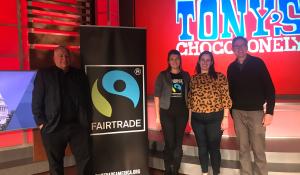
When it comes to Halloween spending, each year seems to break more records. In 2019, the National Retail Federation expected the 172 million people who celebrate Halloween to spend a whopping $86.79 per person, mostly on costumes and candy. That money adds up to a staggering $8.8 billion across the nation.
While you’re searching Pinterest and Buzzfeed for costume inspiration, don’t forget about what your Halloween budget is supporting. Making the holiday more sustainable for you and the Earth could mean joining 10% of Halloween shoppers at thrift stores, or hitting up local businesses like seven percent of shoppers. Here are a few more ideas to make your Halloween more green.
Swap Out Your Halloween Costumes
Unless you’ve got your cat ears on repeat, part of the fun of Halloween is the novelty of finding or making the perfect costume. Consider swapping costumes to reduce and reuse this Oct. 31st.
Costume swaps cut back on waste and reduce the resources used for making, packaging, and transporting new costumes. Plus, hosting a swap is easy, fun, and saves money. National Costume Swap day is officially the second Saturday of October, but the idea is easy enough no matter which day you pick.
You can swap with a few family members and friends, or, better yet, hold a community swap!
If you choose to do the latter, book your swap at a school, community center, park, or host at home. Publicize! The more people come, the better the pickings will be as far as sizes and variety. Invite neighborhood families and friends, and share on social media and through local public bulletin boards or listservs. The host or a volunteer can bring unwanted costumes to a local thrift store at the end of the event. Families can also promote reuse and save money by making costumes by hand from items you have at home.
Candy’s Not So Sweet
Washington mom Corey Colwell-Lipson founded a movement called Green Halloween in 2006 to revolutionize the holiday to make families healthier and greener. One of her ideas was to deemphasize the tradition of handing out candy, because it encourages unhealthy eating habits and often supports bad labor practices in the chocolate industry.
Colwell-Lipson encourages families to give out healthier treats and non-food treasures to trick-or-treaters. Ideally, treasures are recycled, natural, or sustainably sourced, and can be enjoyed year-round. During the first year of Green Halloween events, Colewell-Lipson introduced thousands of kids to treats like polished stones, temporary tattoos, and friendship bracelets—and asked them what they thought.
“We were floored—absolutely shocked—that first season when at [Green Halloween] events, thousands and thousands of kids came by, and not one single child of any age, toddler to teen, said that they would rather have candy when they saw the alternatives. Not one,” Colwell-Lipson says. “What was interesting was that it was the parents who had the harder time making the leap.”
For those who want to give out more traditional treats, there are many organic and all natural options—from organic and fair trade chocolate to sustainable chewing gum. If you’re buying chocolate, it’s particularly important to choose fair trade chocolate, as many conventional chocolate companies have ties to child labor.
Nontoxic Face Paint
A 2009 study by the Campaign for Safe Cosmetics found that ten out of ten children’s face paints tested contained at least trace levels of lead. Exposure to lead is unsafe at any level, according to the Centers for Disease Control and Prevention. Children exposed to lead can later develop hyperactivity and aggression and are at risk for fertility problems, Alzheimer’s, and Parkinson’s disease.
In the same study, six out of the ten products also contained at least one of the toxic heavy metals nickel, cobalt, and chromium in quantities much greater than the levels that scientists recommend. Exposure to these heavy metals has been linked to cancer.
When dressing up little ghouls and goblins on Halloween, parents can either make or purchase healthier face paints. Check out our ideas for better face paint.
Green Halloween Treats
GreenHalloween.org is a resource to green your Halloween. The project started by Colwell-Lipson is now dormant, but the website still includes a guide to hosting your own Green Halloween party, toolkits for holding a community event or Costume Swap, treat and treasure ideas for trick-or-treaters, homemade costume hints, DIY face paint instructions, arts and crafts ideas, energy conservation tips, downloadable posters, kids’ activities, and more!
Bite-sized Chocolates
These sustainably sourced chocolate companies offer mini pieces perfect for trick-or-treaters, using all-natural, fair trade, and/or organic ingredients:
Alter-Eco Chocolate
Divine Chocolate
Endangered Species Chocolate
Equal Exchange Organic Chocolate
Unreal Candy
Healthier Treats
Cascadian Farm Chewy Granola Bars: Organic bars.
Glee Gum: All-natural, Fair Trade chewing gum.
Honest Tea Honest Kids Juice Pouches: Organic fruit juice.
Plum Organics Kids Yo’ Drops: Fruit bars and snacks
Surf Sweets: Organic gummy bears and jelly beans.
Treasures
Greenline Paper Company: Pencils made from recycled money or cast-off blue jeans.
Education and More: Fair Trade friendship bracelets.
Nontoxic Face Paint
Campaign for Safe Cosmetics: Recipes for homemade face paint.
Green Halloween DIY face paint video
Natural Earth Paint: handmade, eco-friendly, and nontoxic paint.
Aveda: brightly colored lipstick and dramatic eye pencils, which can later be used as day-to-day makeup in addition to face paint.
Other Items
ChicoBag Company: Reusable, collapsible trick-or-treat bags.
Sarah’s Silks: Handmade, eco-friendly silk cloths in a variety of colors, easily transformed into capes, skirts, belts, and robes. Also carries other dress-up items.
Updated October 2023







